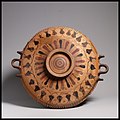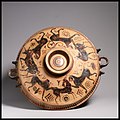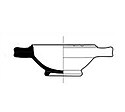Lekane
Lekane[1] (stgr. λέκανη lekánē, l.mn. stgr. λεκᾰ́ναι lekánai) – rodzaj starożytnego greckiego naczynia ceramicznego, misy z uchwytami używanej do obmywania rąk podczas posiłków lub czynności kuchennych.
Charakterystyka
Misy typu lekane przyjmowały różne formy uwzględniając ich głębokość. Mogły być wyposażone w imadła, zarówno poziome jak i pionowe. Występowały też jako całkowicie pozbawione uchwytów. W przeciwieństwie do podobnych kształtem naczyń, zwanych lekanis (stgr. λεκανις), nie miały pokrywek[2].
Przy klasyfikowaniu naczyń tego rodzaju ceramologom trudno jest zastosować jednoznaczne kryterium dotyczące głębokości. Ogólnie uznawany jest podział na lekanai głębokie i płytkie; pierwsze są zwykle głębsze niż typowe głębokie misy, podczas gdy lekanai płytkie , np. typu 2., są często płytsze niż płytkie misy. W związku z tym trudne jest też jednoznaczne określenie ostatecznej funkcji konkretnej lekane. Mogły być używane do obmyć, ale też przy wyrabianiu ciasta na chleb, przy mieszaniu różnych składników w większych ilościach lub do podawania jedzenia, a nawet wina[3].
Formy podstawowe
Podstawowy typologia form, rysunki profilów i przekrojów[3]:
Kształty i typy
Terrakotowa lekane attycka, koniec VIII w. p.n.e. (Metropolitan Museum of Art)
Lekane z Chios, znaleziona w Egipcie, ok. 625–610 p.n.e. (Muzeum Brytyjskie)
Czarnofigurowa lekane attycka, 600–575 p.n.e. (Narodowe Muzeum Archeologiczne w Atenach)
- (c) Jerónimo Roure Pérez, CC BY-SA 4.0
Lekane apulijska z pionowymi uchwytami, ok. 360–340 p.n.e. (Narodowe Muzeum Archeologiczne w Madrycie)
Zobacz też
Przypisy
- ↑ Agnieszka Fulińska: Kształty waz greckich (pol.). hellenika.wordpress.com. [dostęp 2022-07-29].
- ↑ Darrell Arlynn Amyx: Corinthian Vase-painting of the Archaic Period: Commentary, the study of Corinthian vases. Berkeley: University of California Press, 1988, s. 466. ISBN 978-05-2003-166-1. (ang.)
- ↑ a b Susan I. Rotroff: American School of Classical Studies at Athens. Hellenistic Pottery. Princeton: ASCSA, 2006, s. 111. ISBN 978-08-7661-233-0. (ang.)
Media użyte na tej stronie
Autor: unknown, Licencja: CC0
Autor: Zde, Licencja: CC BY-SA 4.0
Large clay basin (lekane) of Archaic times. Archaeological museum of Lavrion.
Autor: unknown, Licencja: CC0
(c) Jerónimo Roure Pérez, CC BY-SA 4.0
Lecane de Zeus venciendo a los gigantes. Grupo de Stuttgart. Altura: 16,20 cm; diámetro máximo: 57 cm; diámetro base: 12 cm. Apulia, 360-340 a. C. Nº Inv. 2008/171/3. Museo Arqueológico Nacional de España.
GIF - Lekane, Form 3
Autor: unknown, Licencja: CC0
Autor: ArchaiOptix, Licencja: CC BY-SA 4.0
object type / vase shape: Chiot East Greek lekane / bowl with basket-like handles, 2 fully plastic female heads on the rim, 4 female heads in high relief at the junctions of the handles
- decoration technique: outline-drawing in dark paint with added dark red on white slip - description interior: animal frieze with 2 lions, 2 geese, 2 dogs attacking a boar, sphinx; inscription (incised after firing): SO_STRATOS MANETHE_KEN TE_PHRODITE_I (Sostratos dedicated me to Aphrodite) - exterior: grazing wild goats - production place: Chios - painter / group: Group of the Aphrodite bowl - period / date: middle wild goat style II, ca. 625-600 BC - height (including handles): 17,8 cm; diameter: 38,8 cm - material: pottery (clay) - findspot: Naukratis, sanctuary of Aphrodite - museum / inventory number: London BM 1888,0601.456 - bibliography: Anna A. Lemos, Archaic Pottery of Chios, Oxford 1991, cat. 252 - John Boardman, Early Greek Vase Painting: 11th-6th Centuries BC, London 1998, fig. 311 - https://www.britishmuseum.org/collection/object/G_1888-0601-456
- Please note: The above museum permits photography of its exhibits for private, educational, scientific, non-commercial purposes. If you intend to use the photo for any commercial aim, please contact the museum and ask for permission.Autor: Picture taken by Marcus Cyron (photo), Licencja: CC BY-SA 3.0
Attic_black-figure_lekane_with_plastic_figures_of_mourners on the rim, nine hunting dogs running to the right; found at the tumuli cemetary of Anagyrus; 600/575 BC.; National Archeological Museum Athens (19177)
Autor: National Museum in Warsaw, Licencja: CC0
Attycka amfora szyjowa czarnofigurowa (142328 MNW), malarz Diosfosa, 500- 475 p. Chr., Strona A: Peleus oddający Achillesa na wychowanie Chironowi, obok pies; strona B: Hermes z kaduceuszem, Maia i baran; postaciom towarzyszą inskrypcje. Warszawa

























